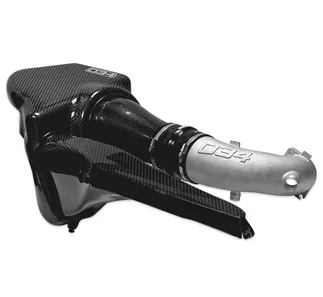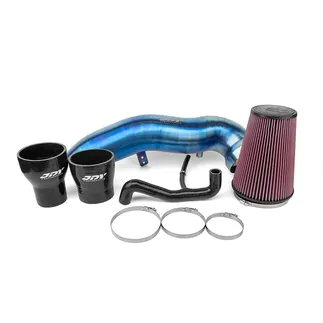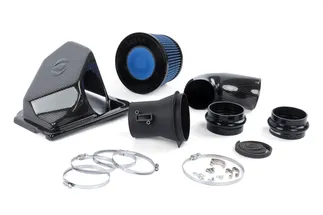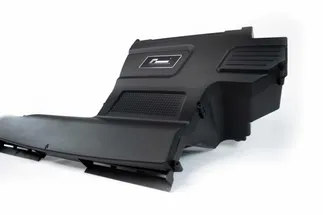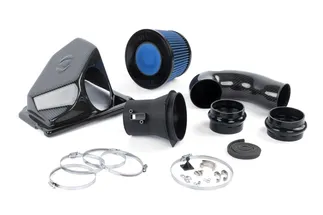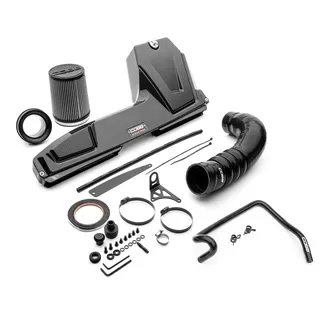Product Information
APR 2.5 TFSI EVO Turbocharger Intake & Inlet System For Audi RS3 & TTRS (Complete Kit System)
- CI100038A - APR 2.5 TFSI EVO Turbocharger Intake System For Audi RS3 & TTRS
- CI100038B - APR Turbocharger Inlet System - Rear Carbon Tube
- CI100038C - APR 4" Turbocharger Inlet Kit - Carbon Tube & Cast Inlet
Additional Adapter Rings & Replacement Filter - Sold Separately
- CI100038-D - APR 59.5mm Adapter Ring For TTE625 v.1 Turbo
- CI100038-E - APR 62.8mm Adapter Ring For TTE625 v.2 & TTE700 Turbos
- CI100038-F - APR 66.0mm Adapter Ring For SRM GTX3582 & TTE777 Turbo (Silly Rabbit Motorsports)
- RF100016 - APR Intake Replacement Filter For Audi RS3 & TTRS
The Inlet Restriction
The factory cast inlet pipe is small. It has a maximum internal diameter of 2.8”, at the widest point, and is internally restricted as illustrated in the photos. This pipe is only capable of achieving a maximum of 490 CFM at 28” of H2O when tested alone. Attaching any intake system to this pipe will only result in a lower flow rate, and when using the factory back pipe, airbox, filter and inlet scoop, airflow drops below 430 CFM.
The APR Solution
Our cast inlet pipe is huge and on its own, it achieves a staggering 710 CFM with the stock turbocharger adaptor! This is a 45% improvement over the factory part. When paired with the APR Intake Filter System, airflow only drops to 690 CFM, a 60% improvement over the entire stock intake system! When attached to the factory airbox, filter and frontal scoop, airflow drops to 575 CFM, which is 34% better than the stock system and 17% better than the stock inlet by itself with an ideal entrance. This further clarifies the point that no intake can outperform the APR turbo inlet if the factory turbo inlet is left intact.
APR’s engineers tested a multitude of other turbocharger inlet designs in pursuit of more flow and power. It was quickly determined the part could not act as an upgrade on its own because of the significant increase in diameter required. The rear inlet pipe also had to be upgraded to utilize this larger diameter. Other designs, which may look smoother, and offer a continuously reducing taper, are extremely limited. At 3.5”, 550 CFM is achievable. At 4” 560 is achievable. In contrast, our system achieves 710 CFM under the same test. Given how restrictive these other designs are, upgrading to our system, while still using the factory airbox, filter, and frontal scoop, will outflow any intake system!
Dyno Testing
The APR Inlet System greatly outflows the factory inlet system, and for this reason, APR’s engineers have created a Stage 1+ ECU to take full advantage of the upgrade. While Stage 1+ is designed for use with an intercooler system, we tested the upgrade with the factory intercooler system to illustrate the gain from the inlet alone. In doing so, the APR Inlet system gained as much as 14 WHP and 11 WFT-LBS of Torque! When adding the APR Intake Filter to this setup, gains grow even further towards redline, adding up to a gain of 32 WHP and 24 WFT-LBS of Torque! When the inlet alone is combined with the APR Intercooler system gains grew further to 37 WHP and 29 WFT-LBS. Gains will continue to grow as higher demands are put on the system via higher stages of performance.
Further Data
APR’s Engineers fully instrumented the engine with pressure sensors and thermocouples (fast response temperature sensors) to further illustrate the effects this product has on the system as a whole. In the simplest terms, this upgrade allows the turbocharger to operate at a lower pressure ratio, which means it will operate more efficiently. It reduces the restriction on the inlet of the turbocharger, allowing the inlet to see closer to ambient pressure conditions. This directly translates to lower pre-turbine backpressure (EMAP), lower turbocharger shaft speed, lower turbocharger compressor discharge temperature, and for the ability to achieve higher boost pressure levels.
The following data was collected with ambient conditions sitting around 985 mbar, 29.4C with 66% relative humidity. The vehicle was setup as Stage 1 (93) with stock hardware, vs Stage 1+ (93) with the APR Inlet. The depression at the inlet decreased by 112 mbar, emap decreased 360 mbar, compressor discharge temperature dropped 14c and the engine was able to achieve 106 mbar more boost pressure by redline. This directly translated to more horsepower and torque, while everything ran cooler and more efficiently.
Fitment:
- Audi RS3 2.5 TFSI (8V) - 2017+
- Audi TTRS 2.5 TFSI (8S) - 2018+
Note: The APR Intake Filter System DV Adapter is required to fit the APR Intake System on 2019+ North American 2.5 TFSI RS3 and TT RS vehicles.

